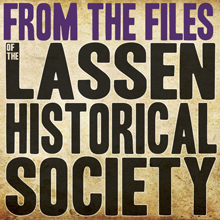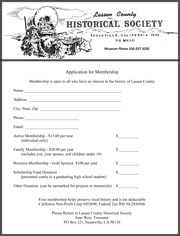

by Susan Couso
Winding through the hills from Graeagle to Plumas Junction, the Sierra Valley Railroad had a rough beginning and a rough ending. In the late 1880’s a railroad through the area was a dream and by the early part of the 20th Century it was no more. But it made a lot of history in its short, complicated life.
In 1880 the Nevada & Oregon Railroad began building north from Reno into Lassen County, where by 1890 it reached the north edge of Honey Lake. The narrow-gauge N&O was an exciting boon to the area and soon the town of Amadee sprang up at the railroad’s terminus.
In 1884, the N&O had reached the site near today’s Hallelujah Junction, at the ‘foot’ of 5,192’ high Beckworth Pass, and this greatly excited the citizens of the isolated Sierra Valley. They envisioned a spur connecting to the N&O which would greatly increase commerce and transportation with the rest of the world.
Work began near Chat, (Plumas Junction) in October 1885, and the narrow-gauge Sierra Valley & Mohawk Railroad began building west toward the communities of Davies Mill (Graeagle) Clairville, and on towards Quincy. They hoped to eventually surpass the difficulties of the Feather River Canyon and connect with the valleys to the west.
But the Sierra Valley & Mohawk suffered one difficulty after another. By 1887 they were forced to sell off items to pay bills. Financial and political upheavals led to a work stoppage, and the construction of the railroad was in jeopardy. The little SV&MRR faced bankruptcy.
Businessman Henry A. Bowen purchased the idle railroad and contracted with H. L. W. Knox to, once again, push the construction forward in 1884. This new venture was named the Sierra Valley Railroad, as the town of Mohawk was just to be another small stop as the rails pushed westward. The tracks finally reached Beckworth in 1895.
On June 20, 1899, a disastrous wreck seemed to foretell the end of the SVRR. One of Mr. Humphrey’s cows wandered onto a trestle and got stuck. Engine No. 2, guided by Engineer Morris J. Chambers, could not stop in sufficient time, and the resulting collision derailed the train, turning it over and off the trestle. Chambers was killed from a concussion to the brain.
Bowen was reported as being deeply disturbed by the incident. The courts determined that SVRR was at fault because they did not fence their property. Chambers’ wife, Cora, was paid damages of $3,000 (at $25 per month) in 1909, funded by the sale of one box car.
With hopes anew, businesses began to spring up along the proposed rail route, but litigations over one thing or another proved to hinder progress and financial gains. The railroad business itself was not as profitable as Bowen had hoped.
Small isolated rail lines were often forced to raise rates due to high maintenance and waning or sporadic business. Reliability was everything. Without reliability, businesses would not make contracts for service.
Bad feelings grew as the lack of money persistently hovered over every decision.
Contractor Knox sued Bowen to recover monies due to him. Bowen charged Knox with abandoning the work and dismantling the tracks, and sued Knox in return.
This spat instigated major suppliers to begin suits of their own. The cases, some going to the State Supreme Court, ended with the railroad being sold at auction. Southern Pacific made a deal to regain some of its ‘rolling stock’ from the beleaguered railway. They paid $2,884 to briefly own the railway and removed their property.
The money went to pay debts, and the Sierra Valley Railroad was back in business. But one lawsuit after another continued to plague the SVRR, and Bowen was tiring of dealing with the shortcomings of his business venture.
Bowen even envisioned a new railroad, connecting at Plumas Junction and ending in Reno. This railroad would bypass the NC&O (the N&O had become the Nevada, California & Oregon in 1885) and go directly via a shorter route to its Reno destination. But Bowen was basically out of money to pursue his dreams and never got beyond the surveying stage of the project.
By early 1901 the NC&O had quietly moved to control the 39-mile-long SVRR. Since 1896 the SVRR had owed $7,435 in back taxes, and the NC&O paid off the debt. Then it provided the money to reballast the railbed, install thousands of ties and provide further maintenance. NC&O didn’t own the railway, but they basically controlled it.
In 1900 the Boca & Loyalton Railroad had been incorporated. This was a wide-gauge railroad which could connect with all the major railways in the country. It had a great advantage over the narrow-gauge systems where cars needed to be unloaded and reloaded onto wide-gauge cars for transition. The Boca & Loyalton was a major competition for the SVRR with its narrow-gauge tracks.
For miles, the B&L tracks ran parallel to the SVRR tracks, and both railways met at Beckwourth. But in 1903 there was a lumber shortage and lumber was vital to railroad construction. The B&L decided to run a short 1.58-mile-long spur line up to Grizzley Creek where there was a timber cutting operation.
Unfortunately, they needed to cross the SVRR line. And that’s just what they did. They simply cut away the SVRR tracks and laid their own B&L tracks through the cut. SVRR had asked for $5,000 to accommodate the cut, but B&L ignored the request.
At the same time the U.S. Postal Service discontinued their contract with SVRR and began shipping mail on the B&L.
Things were ‘hot and heavy’ as tensions escalated. A group of 150 men were sent from Reno to tear up the B&L tracks and reinstall the SVRR rails. Sheriff Hall was called in and rushed to the site with an injunction from Plumas County Superior Court, as excited citizens anxiously gathered to discuss the situation and watch the fight begin.
The SVRR was forbidden to make a move and so was the B&L. The Safe Deposit & Loan Co. of San Francisco held a lien on the SVRR, and they stepped in to secure their rights. They sued in Lassen County Superior Court and won a decision from Judge Kelley who ordered that the B&L tracks be removed.
A large contingent of men arrived on the SVRR to do the job. Another group of men arrived on the B&L, but they simply watched as the tracks were restored to their original state. Disaster averted.
In 1907 the Safe Deposit & Loan Co. began proceedings to foreclose on the SVRR as they had defaulted on their $300,000 loan. By 1909 the Plumas County Sheriff secured the property with fencing, halting all rail traffic. The little 39-mile-long Sierra Valley Railroad was no more.
The railway was eventually absorbed into the NC&O Railroad, which, as wide-gauge systems took over everywhere, subsequently met the same fate.

If you are a fan of our weekly history stories you should join the Lassen County Historical Society! It’s a fun way to be a part of our county’s rich history. When you sign up, you’ll receive regular Historical Society newsletters with interesting stories and information. Membership is open to anyone with an interest in area history.
Through your membership you help preserve local history. You can download a membership application by clicking here.



